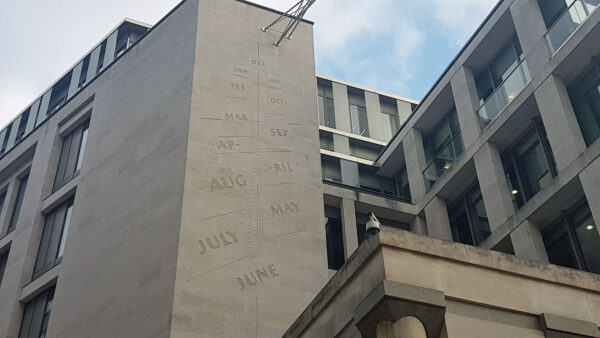It’s quite easy to miss for such a large object, but high up on the wall of the Stock Exchange building is a giant sundial. It’s however a curious device, for it tells the time by the day and month, not the hour.
If you are there around noon on one of those rare sunny days, then a shadow of the arm, topped with a round disc will form on the carved analemma in the stone, and show you what month you are in.
For about 36 years (not far short of the design life of the building) the declination at noon on a particular date will correspond to a line drawn somewhere through the strip for that date. If the building lasts longer than that, thanks to the precession of the sun, the sundial will start to lose a tiny bit of its accuracy.
If you look exceptionally closely, and have very good eyesight, you might notice that there’s a really thin strip at the end of the February month — for those occasions when the month contains 29 days.
Spring and Autumn equinoxes are also here, marked by lines in March and September; Summer and Winter Solstices by vertical lines in June and December.
The sundial was made by the Lida Cardozo Kindersley Workshop, and the sundial maker Frank King.









Not to tell you the date – It’s the other way round. The original purpose of a noon-mark sundial was that a business or household would know the date but would have clockwork clocks that needed regularly checking and setting as they may not be accurate. In the days before the Greenwich time pips on the radio, or dialling “TIM” on the phone all that was needed was to send someone to a noon mark sundial with a pocket watch; Set the watch to noon when the shadow was exactly on the bar corresponding to the date; and then take the watch back and walk round the building setting the clocks.
When we all kept “local time” noon was when the sun was due south and a noon-mark sundial would just be a vertical line. Depending on the time of year most days days would be either shorter or longer than a 24 hour period measured on a perfect clock.
As clocks became more widespread we moved to using mean time so every day is 24 hours long, but the time when the sun is due south is before or after noon by varying amounts through the year, except for just four days when it coincides so the noon mark lies on the figure-8 shape.
Nice to have a modern one on the Stock Exchange building as a reminder of the days when clocks could be unreliable. I
I see the Cardozo Kindersley Workshop,as it’s now known, in Cambridge, is still on the go. Nice.